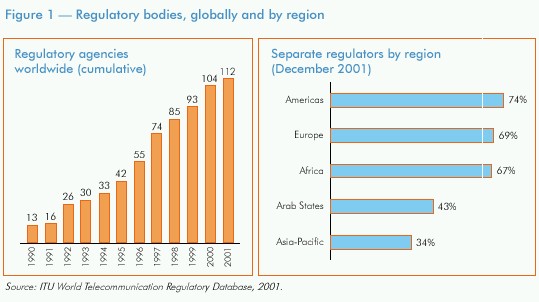Trends 2002
 Trends 2002
is the fourth edition of Trends in Telecommunication Reform. This
new edition provides a detailed insight into effective regulation. In keeping
with the tradition established in earlier editions, Trends 2002 includes
one chapter highlighting global trends in market reform. The other chapters
explore why regulators are needed, the institutional framework of regulation,
general and specific regulatory functions and powers, transparency and fairness,
staffing and financing. This article highlights some of the ways to achieve
effective and transparent regulation. Trends 2002
is the fourth edition of Trends in Telecommunication Reform. This
new edition provides a detailed insight into effective regulation. In keeping
with the tradition established in earlier editions, Trends 2002 includes
one chapter highlighting global trends in market reform. The other chapters
explore why regulators are needed, the institutional framework of regulation,
general and specific regulatory functions and powers, transparency and fairness,
staffing and financing. This article highlights some of the ways to achieve
effective and transparent regulation.
Why effective regulation?
In the last decade, the reform of the
information and communication technologies (ICT) sector resulted in major
changes at the regulatory and institutional levels. One of the most striking
changes has been the rise of regulatory agencies for telecommunications and
related industries. More than 110 governments around the world have created
regulatory entities and many more are planning to do so in the near future. The
rise in regulatory agencies is due to the fact that countries have recognized
that the most fundamental task of ICT sector reform is to establish an effective
and transparent regulatory authority.
 In many ways regulators are like a lighthouse shining a path
of light into a safe and prosperous harbour. They provide a signal that their
market has the security of clear investment rules applied in a fair and
transparent fashion. Although regulators themselves do not ply the waters of
trade and commerce or operate the “shipping lanes” of ICT networks and
services, or sell products or services to customers, they, like a lighthouse,
create a climate conducive to enabling those that do to conduct their business.
They enable networks to be rolled out, new services to be launched, create new
job opportunities and ensure that customers are satisfied. It is for this reason
that the image of a lighthouse was selected for the cover of Trends in
Telecommunication Reform 2002: Effective Regulation. In many ways regulators are like a lighthouse shining a path
of light into a safe and prosperous harbour. They provide a signal that their
market has the security of clear investment rules applied in a fair and
transparent fashion. Although regulators themselves do not ply the waters of
trade and commerce or operate the “shipping lanes” of ICT networks and
services, or sell products or services to customers, they, like a lighthouse,
create a climate conducive to enabling those that do to conduct their business.
They enable networks to be rolled out, new services to be launched, create new
job opportunities and ensure that customers are satisfied. It is for this reason
that the image of a lighthouse was selected for the cover of Trends in
Telecommunication Reform 2002: Effective Regulation.
Sector reform
Sector reform has become the norm for
ITU Member States, a majority of which have at least initiated a sector
reform programme, if not fully embarked on the path of sector reform. The
momentum of the global sector reform movement that crystallized during the 1990s
carried over into the new century, even as the economic boom of the 1990s in
many countries plateaued and faltered. While the cooler economic outlook of 2001
clearly had an effect on sector restructuring — particularly on planned
privatizations and spectrum auctions — governments continued their commitment
to opening markets to competition in order to better meet their universal
service goals.
 As governments began to authorize competition for a growing
array of services, they discovered that they could not simply declare markets
open and walk away. Indeed, in many, if not most countries — particularly
those with long histories of government ownership of telecommunication operators
— functioning markets for telecommunication services could hardly be said to
even exist. Telecommunications in those countries was a government utility, not
a service subject to market forces. Simply declaring telecommunications “competitive”
did not ensure that any new market entrants would, or could, actually begin
competing. As governments began to authorize competition for a growing
array of services, they discovered that they could not simply declare markets
open and walk away. Indeed, in many, if not most countries — particularly
those with long histories of government ownership of telecommunication operators
— functioning markets for telecommunication services could hardly be said to
even exist. Telecommunications in those countries was a government utility, not
a service subject to market forces. Simply declaring telecommunications “competitive”
did not ensure that any new market entrants would, or could, actually begin
competing.
It became apparent that government action and guidance was
necessary in nearly every country — including developed ones — at least in
order to nurture competition to the point where it could survive on its own.
Moreover, the most pressing competitive issues, such as interconnection,
licensing, and pricing, demanded a high level of regulatory expertise. Thus, the
need for regulators became more acute, not less.
Since nearly every country in the world now allows
competition for at least some telecommunication services and in a growing number
of countries sector reform programmes are based on consumer needs, governments
face three fundamental questions:
-
What should “regulation” be in markets that are in
various stages of transition to competition?
-
What is the best institutional approach for each
government to take in dealing with market conditions it finds within its own
country?
-
How should governments ensure that consumers’ needs are
met?
New regulatory institutions
Increasingly, governments are finding
the answers to these questions in legislation setting up new regulatory
institutions, or reforming existing ones. Obviously, in a country only just
emerging from the monopoly PTT model and spinning off a commercial
operator, it may be necessary to create a regulatory authority for the first
time. But even governments with existing regulatory bodies are re-examining the
structures and mandates of those agencies, with an eye towards coping with
perceived market changes, including the “convergence” of voice, data, and
multimedia industries.
In many ways regulators are like a lighthouse shining
a path of light into a safe and prosperous harbour
|
Governments are turning more and more to specialized, even
technocratic, institutions. In many cases, these are separate agencies or
offices, headed by commissioners or appointed chief executives. In a few cases,
they remain semi-autonomous units within government ministries. In either case,
the regulatory authorities are designed to house and mobilize the specialized
talents that governments need to act as promoters and developers of growing,
competitive telecommunication markets.
As the new report emphasizes, the whole point in creating
these institutions is to establish effective, independent regulatory regimes
that provide optimal conditions for private-sector investment in infrastructure
and services. One of the most crucial of those conditions is regulatory
stability. Investors seek clarity in policy-making, equity in policy
implementation, and consistency in regulatory enforcement.
Competition and private investment, particularly in the
developing world, is viewed as a tool for achieving social and economic goals
such as providing for universal access or introducing new broadband technologies
that will induce greater productivity in the overall economy. Regulators in most
countries are expected to have these ultimate societal goals in mind as part of
their public interest mandate.
How, then, can regulatory authorities be sufficiently
effective and transparent to live up to their mandates?
The report explores this essential
question. It also shows that there is a global trend towards retooling
and establishing regulatory structures. Moreover, there are remarkable
similarities in the issues that all governments face when they attempt to
establish effective regulatory regimes. All governments must deal with resource
issues, the delegation of powers to regulators, and defining the long list of
regulatory tasks those regulators must perform. Many regulators around the world
— in developing and developed countries alike — are dealing with these
issues in constructive and innovative ways, for example, by establishing
less-hierarchical organizations, by using training and employee benefit
programmes, and by taking advantage of the Internet to provide public
information as well as for public consultation processes.
It is to be hoped that in exploring these issues and creative
responses, the report will be a catalyst for further innovation and
experimentation through sharing of experiences and approaches among regulators
and other telecommunication professionals worldwide.
| Contributed by Doreen Bogdan-Martin and Nancy Sundberg,
ITU/BDT. For more information on the new report, consult
www.itu.int/ITU–D/treg/ |
|